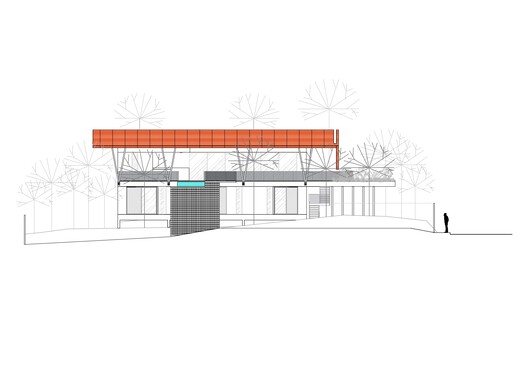
-
Architects: Laurent Troost Architectures
- Area: 4338 ft²
- Year: 2020
-
Photographs:Joana França
-
Manufacturers: Aluminios Rocha, Gerdau, Jatobá, Tegape
-
Lead Architects: Laurent Troost

Text description provided by the architects. Located near a small lake that flows into the Tarumã River, in the city of Manaus, Casa Tarumã was designed based on several principles of passive sustainability to ensure the thermal comfort of its users: adequate installation, generous eaves, dimensioning, and orientation openings to maximize cross-ventilation, as well as the preservation of local ecological systems.




To preserve a large part of the forest and minimize deforestation, the main architectural strategy was to insert the main volume in a cut through the sloping land, inverting the typical housing typology. At Casa Tarumã, the rooms are located on the lower floor and the indoor living spaces, the outdoor seating, and the pool are located on the upper floor.

In order to optimize the relationship between external and internal spaces and to optimize exposure to climatic factors, the house was divided into two volumes: a longitudinal one and a small tower volume, accessible by narrow walkways. The slender volume houses functions that need to be protected from the sun and rain, such as the living room, dining room, and suites, while the tower volume houses functions that do not need to be protected from the sun, such as the storage room, the laundry facilities on the lower floor and the pool and viewing platform on the upper floor.



Conceived as an independent structure from the rest of the house, the corten steel roof of the main volume features 2 pitches with an air draft at the rear, allowing the fruition of the winds and the creation of an air mattress between the roof and the cooled environments, allowing for a good thermal comfort of the living space of the house's upper floor. The roof received a vertical plane on the setting sun side for greater protection from the equatorial sun and privacy of the house. The reduced width of the main volume was planned to ensure cross ventilation in all environments. With its sliding windows on two sides, the glazed living room on the upper floor allows for total integration with the covered living room, the pool, and nature.

To paraphrase Armando de Holanda, this project's main goal was to create “a shady, open, continuous, vigorous, welcoming and involving architecture which, by putting us in harmony with the tropical environment, encourages us to live in it fully.”

































